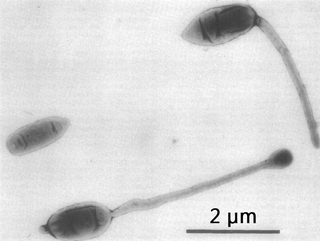Related Research Articles

The Hyphomicrobiaceae are a family of bacteria. Among others, they include Rhodomicrobium, a genus of purple bacteria.
Halopiger is a genus of archaeans in the family Natrialbaceae that have high tolerance to salinity.
Undibacterium is a genus of Gram-negative, oxidase- and catalase-positive Betaproteobacteria in the Oxalobacteraceae family. Undibacterium bacteria occurs in drinking water.
Acinetobacter boissieri is a gram-negative, oxidase-negative, catalase-positive, strictly aerobic nonmotile bacterium from the genus Acinetobacter which was isolated from plants' floral nectar pollinated by wild Mediterranean insects. Acinetobacter boissieri is named after botanist Pierre Edmond Boissier.
Labrys wisconsinensis is a facultatively anaerobic bacterium from the family Xanthobacteraceae, which has been isolated from a water sample from the Lake Michigan in Wisconsin in the United States.
Pseudolabrys is a genus of bacteria from the family of Nitrobacteraceae. Up to now, only one species of this genus is known.
Pseudolabrys taiwanensis is a Gram-negative, rod-shaped bacteria from the family of Nitrobacteraceae which has been isolated from soil from Sinshe in Taichung County in Taiwan.
Pseudoxanthobacter is a genus of Gram-negative, rod-shaped, aerobic and nitrogen-fixing bacteria from the family Pseudoxanthobacteraceae.
Parvibaculum hydrocarboniclasticum is an aerobic bacterium species from the genus of Parvibaculum which has been isolated from hydrothermal fluids from the East Pacific Rise in the Pacific Ocean. Parvibaculum hydrocarboniclasticum can use n-alkanes like octane, dodecane and hexadecane as a sole source for carbon and energy.
Chryseobacterium hispalense is a Gram-negative and non-motile bacteria from the genus of Chryseobacterium which has been isolated from a rainwater pond in Spain. Chryseobacterium hispalense can promote plant growth.
Sphingobacterium psychroaquaticum is a Gram-negative and psychrophilic bacterium from the genus of Sphingobacterium which has been isolated from lake water from the Lake Michigan in Wisconsin in the United States.
Pontibacillus is a Gram-positive, spore-forming and strictly aerobic genus of bacteria from the family of Bacillaceae.
Frondihabitans australicus is a Gram-positive and aerobic bacterium from the genus Frondihabitans which has been isolated from leaf litters from Southeast Queensland in Australia.
Epibacterium is a genus of bacteria from the family of Rhodobacteraceae.
Pelagimonas is a Gram-negative, heterotrophic and aerobic genus of bacteria from the family of Rhodobacteraceae with one known species. Pelagimonas varians has been isolated from seawater from the North Sea in Germany.
Planktotalea is a genus of bacteria from the family of Rhodobacteraceae.
Pseudooctadecabacter is a genus of bacteria from the family of Rhodobacteraceae with one known species.
Kaistiaceae is a family of Alphaproteobacteria.
Pleomorphomonadaceae is a family of Alphaproteobacteria.
References
- 1 2 LPSN lpsn.dsmz.de
- ↑ Straininfo of Parvibaculum lavamentivorans
- 1 2 Deutsche Sammlung von Mikroorganismen und Zellkulturen
- ↑ UniProt
- ↑ Schleheck, D; Tindall, BJ; Rosselló-Mora, R; Cook, AM (September 2004). "Parvibaculum lavamentivorans gen. nov., sp. nov., a novel heterotroph that initiates catabolism of linear alkylbenzenesulfonate". International Journal of Systematic and Evolutionary Microbiology. 54 (Pt 5): 1489–97. doi:10.1099/ijs.0.03020-0. hdl: 10261/102133 . PMID 15388700.